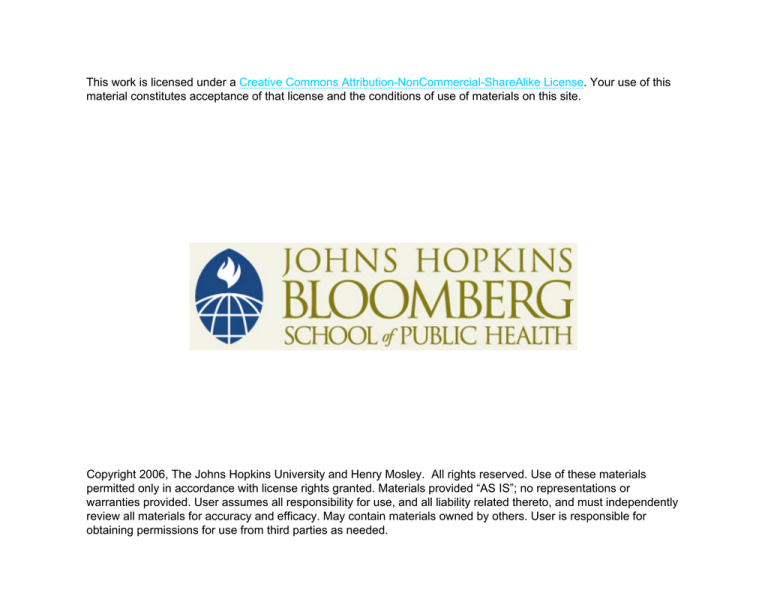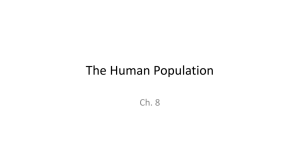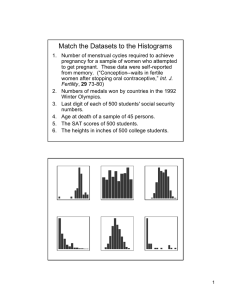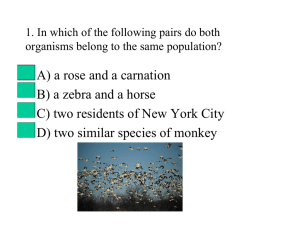
This work is licensed under a Creative Commons Attribution-NonCommercial-ShareAlike License. Your use of this
material constitutes acceptance of that license and the conditions of use of materials on this site.
Copyright 2006, The Johns Hopkins University and Henry Mosley. All rights reserved. Use of these materials
permitted only in accordance with license rights granted. Materials provided “AS IS”; no representations or
warranties provided. User assumes all responsibility for use, and all liability related thereto, and must independently
review all materials for accuracy and efficacy. May contain materials owned by others. User is responsible for
obtaining permissions for use from third parties as needed.
Fertility Change
Fertility Trends and
Differentials
TFR
6.5 to 7.5
5.9 to 6.4
5.5 to 5.8
4.3 to 5.4
2 to 4.2
(11)
(12)
(7)
(13)
(11)
Module 5a
Learning Objectives
Upon completion of this module, the student will
be able to
Describe the trends and differentials in
fertility over time and place
Trends and differentials in age specific fertility
rates over time and place
3
The Fertility Transition
Definition
Generally defined as having started in a
country when there is at least 10%
decline in fertility which begins an
irreversible trend downwards
Said to be “completed” when
replacement level fertility levels are
achieved
4
Fertility Transition
Current Status
Began in most industrialized countries in the
late 19th century and competed by early/mid
20th century
Began in most of Asia and Latin America after
World War II and completed or nearing
completing in some (e.g., Brazil, Thailand,
China)
Just beginning in most sub-Saharan African
countries
5
Total Fertility Rates by Region of the
Developing World,1950-55 to 1985-90
Source: Fig1, Bongaarts and Watkins,1996
6
Decline in Fertility by World
Region,1950-55 to 1990-95
Latin America
&Carribean
3
5.9
1990-95
1950-55
2
North America
3.8
1.6
Europe
2.6
2.9
Asia
5.9
5.9
SSA
6.6
0
1
2
3
4
5
6
7
Total Fertility Rate
Data Source: UN, World Population Prospects: The 1998
revision
7
Africa – Regional Map
Northern
Western
Eastern
Middle
Southern
Map by: Adam78 via Wikimedia Commons. Some rights reserved.
8
Decline in Fertility in Africa by
Region
6
West Africa
6.4
3.7
Southern Africa
6.5
4
North Africa
6.8
1990-95
1950-55
6.5
5.9
6.2
6.9
Middle Africa
East Africa
5.9
6.5
SSA
0
2
4
6
Total Fertility Rate
8
Data Source: UN, World Population Prospects: The 1998 revision
9
Total Fertility Rates in Africa,
1999
TFR
6.5 to
5.9 to
5.5 to
4.3 to
2 to
7.5
6.4
5.8
5.4
4.2
(11)
(12)
(7)
(13)
(11)
Source: World
Population Data
Sheet, 1999,
PRB
10
Trends in Age Specific Fertility
Across Regions
During fertility transition, the proportion of
decline in fertility may not be same across
age groups
With delay in age at marriage over time
with no concomitant increase in premarital
fertility, the fertility in age group 15-19 will
decline over time as observed in East Asia,
esp. in Japan
11
Trends in Age Specific
Fertility Rates Across Regions
However, in some regions e.g. in Southern Africa,
an increase in fertility in 15-19 year age group is
observed over time.
Further, the fertility patterns may shift up with
delay in initiation of child-bearing with rising level
of women’s education and labor force
participation
Fertility may decline disproportionately in higher
age groups with rise in use of contraception in
these age groups
12
Trends in
ASFR over
time across
different
regions
Source: UN,
World Fertility
Patterns,1997
13
Summary Slide
This concludes this session, the key
concepts introduced in this session include:
– Fertility transition
– The status of fertility transition in
different countries around the world
– The trends and differentials in fertility
across different regions of the world
and among different countries in SSA
14
Fertility Change
Determinants of Fertility Trends
and Differentials
TFR
6.5
5.9
5.5
4.3
2
Module 5b
to
to
to
to
to
7.5
6.4
5.8
5.4
4.2
(11)
(12)
(7)
(13)
(11)
Learning Objectives
Upon completion of this module, the student will
be able to :
Describe the proximate and underlying
determinants of fertility responsible for
observed trends in fertility
16
A Model of Fertility Change
Underlying Determinants
(Socio-economic, cultural and other factors)
Proximate Determinants
(Biosocial mechanisms)
Fertility
(Biological processes)
17
Fertility: Biological Processes
18
Fertility – Biosocial
(Proximate) Determinants
Davis and Blake (1956) introduced
the concept of “proximate” or
biosocial determinants – that is,
behavioral factors that directly
affect the biological processes
controlling fertility.
continued
19
Fertility – Biosocial
(Proximate) Determinants
Bongaarts (1982) provided an analytical
model for measuring in surveys the most
important proximate determinants that
affect fertility.
20
Bongaart’s Proximate Determinants
1. *Proportion of women in a sexual
union (married)
2. *Use of contraception
3. *Post-partum amenorrhea (due to
breastfeeding)
4. *Induced abortion
5. Frequency of intercourse
6. Spontaneous fetal losses
7. Sterility (due to disease)
* Major determinants of variability in
fertility in most populations.
21
The four most important proximate
determinants - based on sensitivity of
fertility levels to changes in these, and
their variability over time and place
Proportion of women in sexual unions
The level of contraceptive use
Duration of postpartum infecundability
The level of induced abortion
These 4 factors substantially account for
the trends and differentials seen in
fertility over time or place
22
The remaining three proximate
determinants
The level of permanent sterility
Frequency of intercourse (fecundability)
Spontaneous intrauterine mortality
Relatively less important determinants of
the trends or differentials in fertility
(though sterility due to disease is
important in some SSA regions)
23
The Contraceptive Revolution
and Fertility Change Since 1960
Trends in Contraceptive Use in
Developing Countries 1960-90
Trends in Fertility in Developing
Countries 1960-90
8
7
6
5
4
3
2
1
0
6.76.5
1960
1990
1960
1990
80%
7
6
5.9
5.1
5.8
0.7
70%
0.6
60%
4.2
3.2
50%
2.6
20%
10%
0.4
0.36
40%
30%
0.08
0.05
0.15
0.11
0.17
0.02
ia
As
E.
.
er
Am
L.
ia
As
S.
r.
Af
A
/N
ME
SS
ia
As
E.
ica
er
Am
L.
sia
.A
So
a
ric
Af
A
/N
ME
SS
0%
24
25
Underlying Determinants
of Fertility in Populations
The underlying determinants of fertility
are those socio-economic, cultural, health
and programmatic factors that result in
changes in reproductive behaviors in
populations.
All underlying determinants must
operate through the proximate
determinants to influence the level of
fertility in a population.
26
Underlying Determinants of
Fertility: Some Examples
♦ Social: education, income, work, status of
♦
♦
♦
♦
women
Cultural: marriage practices, post-partum
abstinence, religious beliefs about contraception
Health: prevalence of STDs, malaria
Political: government policies regarding family
planning, female education
Programmatic: availability of contraceptive
information and services
27
re
Ke a 1
C n y 99
5
o
M mo a 1
ad ro 99
ag s
8
as 19
c 9
M ar 6
a 19
R law 9 7
w i1
a
Ta nd 99
nz a 1 2
a 9
U nia 92
g
So an d 199
M uth a 1 6
oz e 99
a m rn
5
bi Afr
N que ica
am 1
ib 9
Za ia 97
Zi mb 199
m
ba i a 1 2
bw 99
Bu W e 1 6
rk es 99
in
a t Af 4
Fa ric
s
a
Be o 1
n i 99
n 9
C
ot CA 1 99
e
d R 6
C 'Ivo 199
am ir
4
er e 1
oo 99
G n1 4
ha 9
G na 98
ui
ne 199
a
8
M 199
N ali 9
ig 19
er 9
ia 6
N 19
Se ige r 90
ne 19
ga 98
C l 19
ha 9
d 7
To 19
go 97
19
98
Er
it
% using modern methods
Contraceptive prevalence rates by the Level of Mother’s
Education, SSA, 1990-1999, Demographic and Health Surveys
60
50
No education
Primary
secondary
40
30
20
10
0
28
Summary Slide
This concludes this session, the key
concepts introduced in this session include:
– The proximate determinant of fertility
– The underlying or distal determinants of
fertility
29
Fertility Change
Classic Theory of
Demographic Transition
TFR
6.5 to 7.5
5.9 to 6.4
5.5 to 5.8
4.3 to 5.4
2 to 4.2
Module 5c
(11)
(12)
(7)
(13)
(11)
Learning Objectives
Upon completion of this module, the student will
be able to :
Describe , interpret and critique the classic
theory of demographic transition to explain
the current and historical trends in fertility
decline
31
Why Does Fertility Decline?
Theories and Controversies
Fertility decline - No uniform pattern,
much diversity in the origin, speed and
correlates in different historical and
geographical setting.
No consensus on a common theoretical
framework.
32
Malthusian Theory of Population
Growth (Early 19th Century)
The “cause” of poverty
Population tends to increase at a geometric
rate
Food can only increase arithmetically
Population expands to eat up any surplus
Subsistence wages forever unless “moral
checks” (abstinence from marriage)
Otherwise “positive checks” on population
growth - misery (wars, famines) and vice (use
of contraception)
33
Why Fertility Declines: The Classic
Demographic Transition Theory
(Notestein and Davis, 1950s)
Socio-economic development leads to:
– Increased supply of children due to
reduced mortality
– Reduced utility of children
– Reduced desired family size
Declining mortality and, after some lag
period, declining fertility follow from
socioeconomic development
34
What Does Empirical Evidence Say
about the Demographic Transition?
Princeton European Fertility Project:
launched in 1963, two decade long
endeavor- designed to test transition theory
with historical data from roughly 700
provincial -level units throughout Europe.
World Fertility Surveys: launched in the
1970s provided evidence on fertility change
from over 40 less- developed countries
35
Relationship between TFR and the Human
Development Index (HDI) for less
developed countries in 1960-65
Source: Fig. 4, Bongaarts and Watkins, 1996
36
Relationship between TFR and level of
development (HDI) for 69 developing
countries,1960-65 to 1985-90
Source: Fig2, Bongaarts and Watkins,1996
37
What Does Empirical Evidence Say
About the Demographic Transition
Theory?
No consistent relationship can found
between the timing of the onset of
fertility decline or level of fertility and
measures of social and economic
development as one looks across
countries
38
Necessary Preconditions for Decline in
Marital Fertility (A. Coale, 1973)
A setting that allows fertility control to be
part of calculus of conscious choice
Clear economic advantages of smaller
family size
Availability of information about, and
means of, fertility control
39
Summary Slide
This concludes this session, the concepts
introduced in this session include:
– Malthusian theory of population growth
– Classic theory of demographic transition
– Necessary preconditions for decline in
marital fertility as proposed by A. Coale
40
Fertility Change
Theories of Fertility Transition
TFR
Module 5d
6.5 to 7.5
5.9 to 6.4
5.5 to 5.8
4.3 to 5.4
2 to 4.2
(11)
(12)
(7)
(13)
(11)
Learning Objectives
Upon completion of this module, the student will
be able to :
Describe , interpret and critique the existing
theories to explain the current and historical
trends in fertility decline
42
Recent Fertility Transition
Theories
Theory of intergenerational wealth flow (Caldwell,
1982)
Easterlin’s theory of supply and demand
(Easterlin an Crimmins, 1985)
Diffusion of innovation theory (Cleland and
Wilson, 1987)
43
Theory of Intergenerational
Wealth Flows
Changes in child labor, compulsory
education, extended families, etc., shifts
child-to-parent “wealth flow” to parent-tochild
Fertility is limited as children become a
burden to the family
Criticism: little empirical evidence to
support this theory
44
Economic Theories of Fertility:
Easterlin theory of supply-demand
Three basic determinants of fertility:
1. supply of children, initially limited by
poor health conditions
2. demand for children for economic and
social reasons
3. cost of fertility regulation, including
social and psychic as well as monetary
costs
Modernization can lead first to a rise and
then to a fall in fertility
45
Economic Theory of Supply and
Demand: Criticism
Does not specify what socioeconomic
variables account for demand for
children
Does not explain the variations in pretransitional marital fertility
46
Diffusion of Innovations
(Ideational) Theory (Cleland
and Wilson)
The key element is diffusion of:
– knowledge (of birth control
methods)
– attitudes (towards use of
contraceptives)
– innovations (in birth control
technologies and behaviors)
47
Diffusion of Innovations
Theory: Implications
Population sub-groups open to outside influence
would be affected first
In the process of transition, fertility differentials
across diffusion barriers (race, language,
education) will first increase, then decline
Fertility decline is most rapid in homogenous
populations
Family planning programs can help to bring about
fertility decline
48
Diffusion of Innovations
Theory: Criticism
Narrow in focus, the human drama of fertility
decline is more than just a technological
issue related to changing contraceptive
behaviors
Places culture out of social, economic and
political context
Limited empirical evidence – e.g., does not
indicate when innovations will actually be
adopted by a population
49
Gaps in Current Theories on
Fertility: Role of Power and Culture
Role of authoritarian political power, e.g, in
China and Indonesia
Role of democratic institutions, e.g., in Thailand
and India
The interaction of cultural traditions and
political decisions, e.g., in Pakistan and subSaharan African
50
Gaps in the Current Theories on
Fertility: Role of Gender
How have gender roles and
relationships shaped reproduction in
different times and different places?
Importance of gender in population
policies has been highlighted in the
1994 International Conference on
Population and Development
Limited research in this area
51
Role of National Family
Planning Programs in Fertility
Decline
Provide information on fertility regulation
methods
Reduce the costs (and enhance the effectiveness)
of contraceptive practice (monetary, time, and
psychic)
May influence demand for children by changing
the social norms about ideal family size, role and
status of women, etc., through IEC activities
continued
52
Role of National Family
Planning Programs
Hard to quantify and separate the effect of family
planning programs on fertility decline from other
socio-economic factors
Mauldin and colleagues (1978,1984,1996)
collected information on FP program effort in
different countries and found a consistent positive
relationship between contraceptive prevalence
and program effort score even when controlling
for level of SE development
53
Is There a Theory of Fertility
Decline Applicable to All Areas?
Fertility transitions are the result of a
complex interaction of social, economic,
cultural and political forces that change
patterns of family formation, family size
desires, and fertility control behaviors
The relative importance of different forces
may be quite different in different settings
There may not be a single theory that fully
encompasses these processes
54
Summary Slide
This concludes this session, the key concepts
introduced in this session include
– Theory of intergeneration wealth flow
– Easterlin’s theory of supply and demand
– Diffusion of innovation theory
– Role of gender, power and culture in fertility
decline
– Role of national family programs in fertility
decline
55






